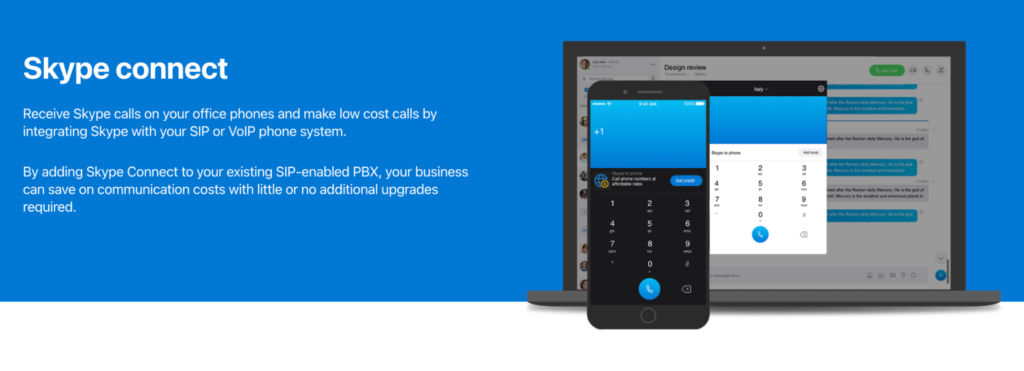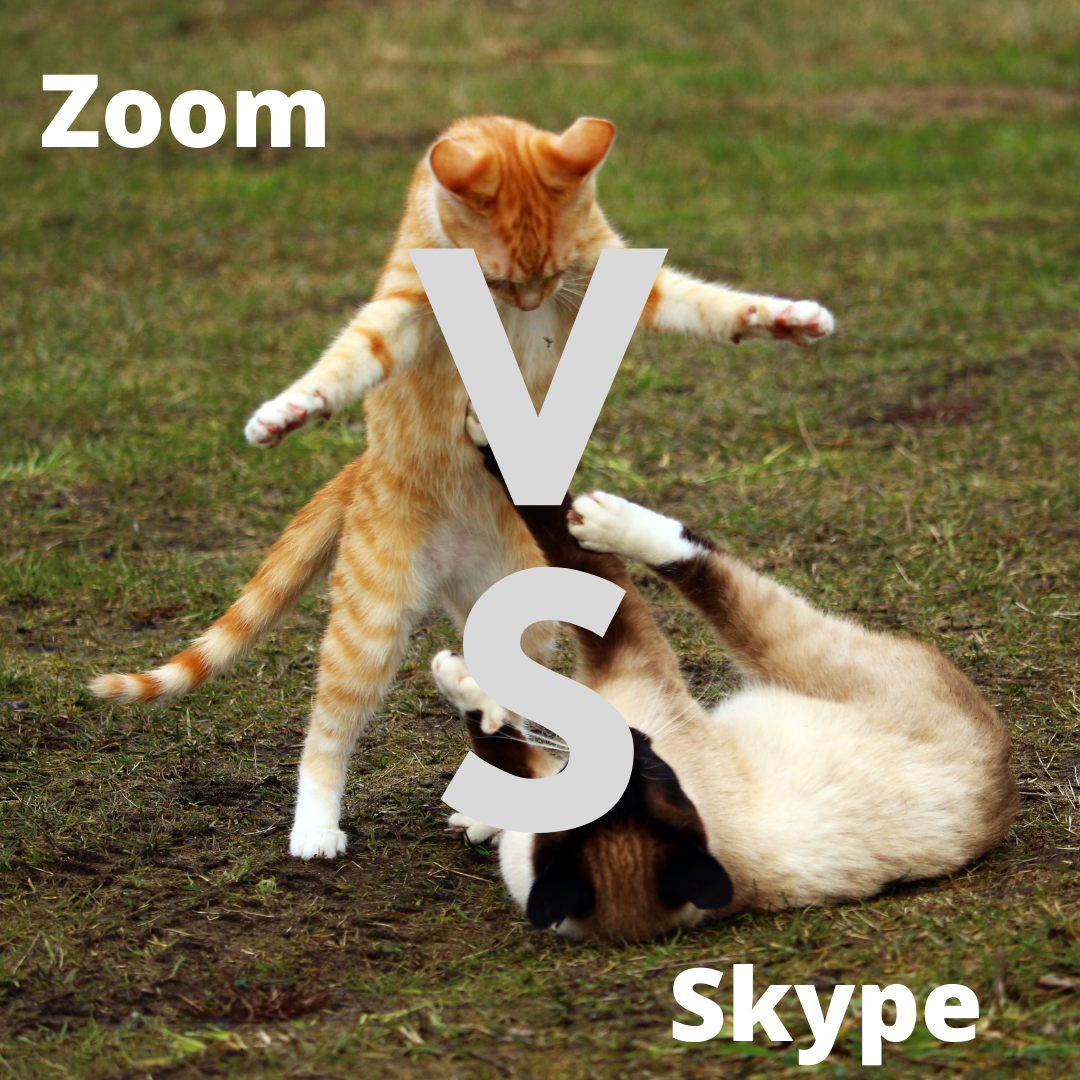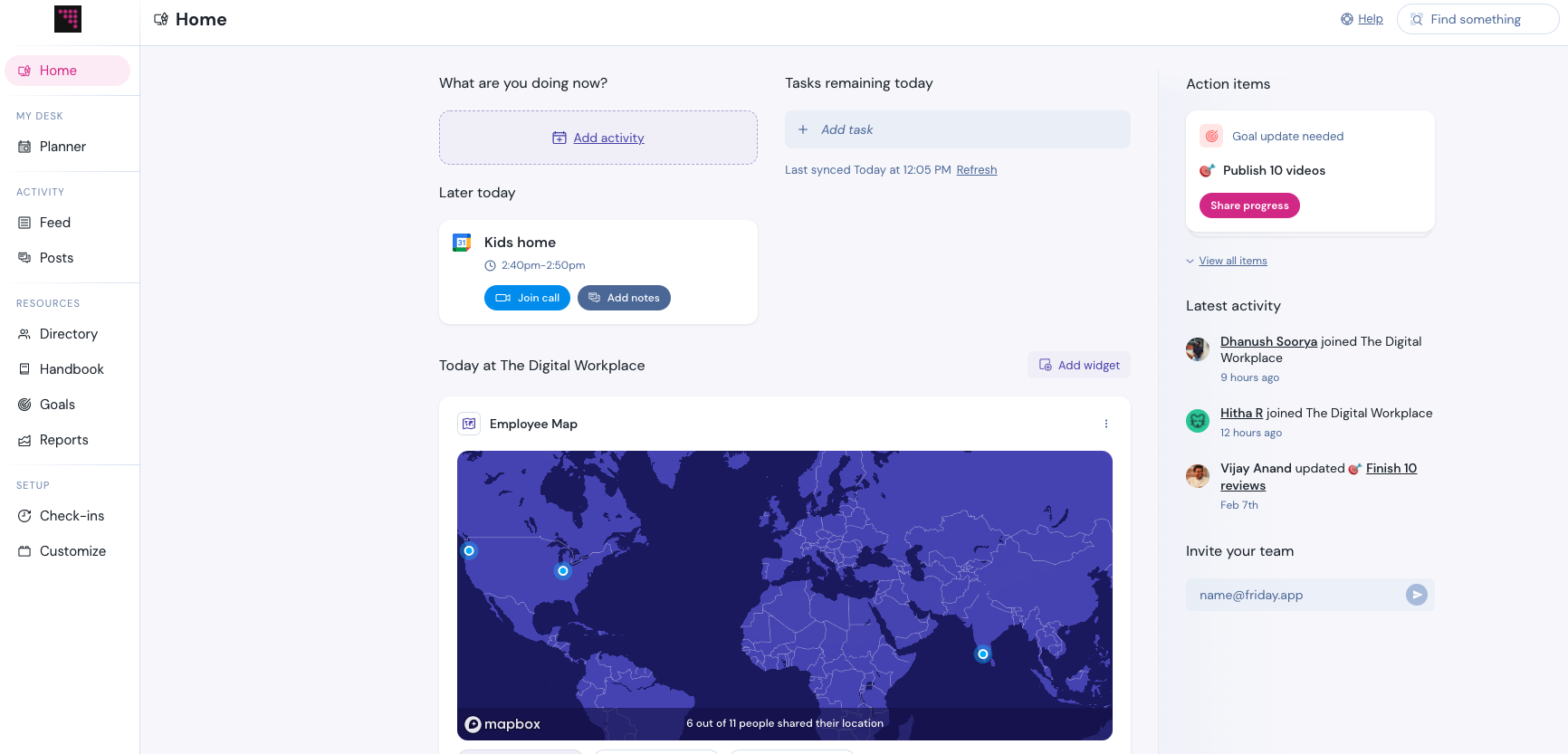If there’s one thing we all had to adapt quickly to in 2020, it was the digital meeting. Everything that was in person shifted to virtual platforms.
Even as the pandemic starts to fade away, virtual meetings for business will continue to be prevalent. Whether it is cutting back on unnecessary travel, or a shift to a hybrid business model, we are going to keep meeting online.
But let’s look at some of the titans of virtual meeting platforms: Zoom vs. Skype.
Before 2010, it was common to say you were going to Skype someone. Yet in 2020, we were Zooming people. What happened? How did Zoom come to dominate the market? And is one platform better than the other?
In this post, we’ll do a detailed Zoom vs Skype comparison to help you identify the best solution for your business.
Zoom vs Skype: The history
Zoom and Skype are two of the most popular tools for digital communication and collaboration.
The key point in this history came in 2011, when Skype was acquired by Microsoft. Microsoft integrated Skype into their office products and then deprecated their own video calling solutions.
Zoom launched to the public in 2013, at a time when it seemed that the video calling market was already very saturated. However, it picked up many key customers and grabbed a very loyal customer base. It launched an IPO in April 2019 and peaked at the right time, just before the pandemic forced everyone to find a video solution immediately.
Product overview
Skype is a simple but effective solution designed to help multiple people communicate through a range of mediums.
You can video call, voice call, and instant message each other, and Skype is compatible with a range of devices – including gaming consoles and smart speakers in some cases. Skype is also free to use, provided you’re calling another online Skype user.
Zoom takes a slightly different approach to collaboration. Though like Skype, Zoom offers video and audio conferencing, as well as instant chat, it was built primarily for video. Zoom offers a host of extra tools for business and personal users, including webinars, virtual backgrounds, call recording, and more.
Zoom vs Skype: How their features stack up
Ease of use
Both Skype and Zoom put user experience first.
Despite Microsoft starting to roll out replacement tools for Skype, like Microsoft Teams, many users have remained within the Skype platform because it’s so simple and intuitive. All you need to do is sign into the app and click on a person you want to connect with. You can send an instant message and launch a meeting with the “Meet Now” button.

Skype also simplifies the act of adding other people to your meeting by giving you a link you can copy and paste to anyone. You don’t even need an account to join a Skype meeting because guest access is supported.
Zoom is equally user-friendly. The simplistic Zoom interface makes setting up a meeting as simple as clicking on your Participants tab and clicking “Invite.” You can copy and paste your invite link to other people you want to connect with too. Zoom’s interface also comes with a customizable control panel that you can remove from the screen when you don’t need it.
Both platforms offer intuitive dashboards and user menus, but Skype’s slightly easier to get around due to its minimalist layout and design.
Video conferencing
Skype and Zoom offer video conferencing, though their features differ a little. Skype makes it simple to launch video conversations fast. It takes a couple of clicks at most to start a meeting, and you can launch either one-on-one or group chats. Skype supports full-screen video, and there’s a background blur option if you’re embarrassed about your surroundings.
But while Skype’s video conferencing is simple, Zoom’s comparable offering leaves little to be desired. The platform has evolved to be the number one tool for video conferencing, making it easy to schedule and join video meetings in various environments. Zoom has various ways to view your video conference, including grid modes for up to 49 thumbnails or “Immersive View,” which places up to 25 people in a shared virtual environment.
Zoom also allows you to elevate your video meetings into webinars and huge conferencing sessions too. While both Skype and Zoom support easy videoconferencing, Zoom is far more advanced.
Collaboration
Conferencing tools like Skype and Zoom are great for communication, but they can support collaboration too. In a hybrid or remote working environment, Zoom and Skype can enable people to work in a shared “virtual” space, with face-to-face video interactions.
Both apps support instant messaging while you’re in a meeting to help with adding context to a conversation, and Skype allows presenters to share their screens too. With Zoom, screen sharing is possible with hosts and participants, depending on the settings for your meeting. Zoom allows users to share their screens or just a portion of it when in a meeting.

Zoom also has a whiteboard tool to collaborate on a shared idea, where you can sketch ideas with your colleagues. Whiteboard functionality is also available in the Skype for Business version of Skype, but it’s not currently supported for the consumer version.
Overall, Zoom is the superior platform for collaborating.
Meeting scheduling
For scheduling meetings, both Skype and Zoom have you covered.
Skype is intended to be a tool that’s accessible to everyone (not just business users). Rather than setting up a meeting room, you’re just scheduling a reminder to let you know you have a call. You can align your Skype application with calendars like Outlook to help with these notifications. If you want more meeting scheduling options, you may need to switch to Teams.
Zoom has a slightly more business-focused approach to meetings. Like Skype, you can schedule a meeting and add it to your calendar (integrations are available with Google and Outlook). You’ll also be able to reserve rooms in a business by linking your technology to Zoom Rooms hardware. Zoom also integrates with a lot of external endpoints for better schedule management.
Call recording
When someone can’t make it to a call or when you need to preserve a meeting for compliance purposes, recording is a must-have. Skype allows users to record any Skype-to-Skype call, including the video content. The recording will remain in the cloud for up to 30 days, and you can also download it to your device whenever you like.
Zoom recordings are available to store on your computer or in the cloud through services like Google Drive and Dropbox. Zoom also allows you to save the file to YouTube and other similar sites. Call recording requires a paid plan on a smartphone.
If you’d like to access your calls for a long period, Zoom is the right choice as it won’t erase your recordings after a certain period.
Participant limits
If you’re using the free version of Skype, you’ll have a meeting participant limit of 50 people. Upgrade to the Skype Meeting premium versions, and you can take your limit much further. Skype Meeting Broadcast, for instance, supports up to 10,000 participants.
Zoom’s free plan hosts up to 100 participants for 40 minutes on its free plan. If you upgrade to a paid version, there’s no time limit.

The most expensive version of Zoom hosts up to 500 participants, but there’s also a video webinar option that supports up to 50,000 attendees.
If you’re looking for a tool that will give you the most participant support for the lowest cost, Zoom is the better option.
Video quality
Both Skype and Zoom support 1080p video conferencing, but Zoom will automatically set your video to 720p. This helps to ensure you don’t use too much bandwidth on a video call. Your hardware will be a big determining factor on how great your video looks, as will your internet connection.
Skype recommends having a 1.2Mbps connection for HD calls, while Zoom recommends having at least 3Mbps. If you live in an area with limited connectivity, you may notice some freezing or blurry, pixelated video at times.
Additional features
Both Zoom and Skype frequently update their feature set to deliver more functionality to end-users. Skype comes with the ability to call local phone numbers and connect with people internationally at a low calling rate. You can also send SMS messages directly from Skype.
Skype allows you to manage your contacts, add people to favorites, block contacts, and mark messages as read or unread. You can also add different ringtones for specific users.
Zoom has various fun features like virtual backgrounds, which take Skype’s blurred backgrounds to the next level. With virtual backgrounds, you can replace a messy office with a beach or pictures of space. Zoom also has a “touch up” option to improve the way you look in a video, and there’s Zoom Phone for external calling too.
In short, Skype has more features from a laid-back consumer perspective, but Zoom is better for video calling and business features.
Security and confidentiality
Both Zoom and Skype are committed to keeping their users secure.
Skype uses the AES standard to protect information – the same encryption used by the US government. Skype calls are also protected by 256-bit encryption.
Zoom also offers end-to-end encryptions for all calls, as well as a range of features designed to reduce external access to your meetings. You can put passwords on meetings and have “waiting rooms” before a conversation to help you decide who you should permit into the conversation. Zoom’s security is growing increasingly impressive since the 2020 “Zoombombing” incident on the platform.
Third-party integrations
Communication and collaboration are easier when all the tools you need to use work on the same platform. Microsoft owns Skype, so it works wonderfully with the Microsoft 365 productivity tools, as well as Outlook for email and calendar management. Skype Connect also supports linking an account to an office phone for external calls.

Zoom is far more versatile when it comes to integrations. The Zoom environment comes with access to a comprehensive app store full of native connections to Office 365, Google Workspace, Slack, and a range of other tools. You can find integrations for CRMs, analytics tools, customer service, education, event management, marketing, monitoring, and more.
Zoom also has an open API system for companies who want to build their own custom connections with the application.
So, in a nutshell, Zoom is the right choice if you’re looking for a video conferencing solution that integrates with various third-party platforms.
Platform compatibility
Zoom and Skype both support users in connecting from a range of devices. Skype has its mobile app for Android and iOS devices. You can also access Skype through a smart assistant speaker or tablet. Skype will work with a wide variety of cameras, headsets, and meeting peripherals.
Zoom works with all the same devices as Skype, plus a few more. Additionally, it offers Zoom Rooms hardware for building your meeting rooms with dedicated devices. Some of these applications come with tools specifically created for Zoom, such as cameras, meeting bars, speakers, touchscreen monitors, and more.
Both Skype and Zoom will work best with a high-speed internet connection, HD camera, and a strong headset with excellent microphone and audio quality.
Zoom vs Skype: Pricing
Both Zoom and Skype are free to use in some aspects.
Skype has a range of free features to use, making it an excellent choice for consumers. You can make calls to anyone on Skype without spending anything. Skype is also free for video conferencing and messaging to other Skype users. However, you can choose to pay for things like:
- Skype to Go: This service allows you to make calls from your cell phone with Skype’s international rate payments.
- Skype numbers: This allows you to create your own number within Skype that other people can call. It’s a handy way to set up a business number as a freelancer.
- Skype credit: This is a “pay as you go” option that allows you to buy the credit you need to make cell phone and landline calls from Skype.
- Skype Subscriptions: Subscriptions allow you to make unlimited calls to landlines and cellphones worldwide. Plans vary depending on where you want to call.
Zoom has a free version that allows you to make video calls one-on-one as much as you want for an unlimited amount of time. You can also host group calls of up to 100 participants for up to 40 minutes. You can also host an unlimited number of meetings and use private or group chat.
The paid versions of Zoom start at:
- Pro: $149.90 per year for unlimited calls to individuals and group calls up to 100 participants. You can also use the “large meetings” add-on to increase participants to 1,000. Group meetings can last for up to 30 hours, and you also get 1 GB of cloud recording and social streaming included.
- Business: $199.90 per year for all the features of Pro, but you can host up to 300 participants, and you get single sign-on, transcripts from your recording, managed domains, and customizable branding.
- Enterprise: $240 per year for all the features of Business, plus you can host up to 500 participants and access unlimited cloud storage.
As you can see, Zoom and Skype have different pricing models. To pick the most cost-effective solution, you’ll need to consider your needs and determine which features are most important for you and your team.
Zoom vs Skype: Customer support
Customer support from both Zoom and Skype can help you address a range of issues. Skype has a searchable database where you can find articles to assist you in fixing common problems. Even if you’re a free user, you can still reach out through chat to get guidance from a virtual agent. Alternatively, you can send questions to the Skype community.
Zoom has its own Help Center and a customer support team. You’ll only be able to submit support tickets if you’re using the free plan. If you’re a paying member of Zoom’s community, you can chat live with a team member. Business plan subscribers can get phone support too. Most support tickets are answered within 24 hours.
Zoom also has various interactive webinars to help you discover the app’s features, and the company posts a range of blogs too.
Both platforms offer various types of customer support, but Skype allows you to get help regardless of the plan you’re on. On Zoom, premium support is only available on the higher-priced plan.
Conclusion
When comparing Zoom vs Skype for video conferencing, it’s clear that both platforms aim to offer the best features and experience.
Skype deserves praise for popularizing video calls and making our lives easier. But Zoom has a richer set of features for calls, with several options to accommodate virtual meetings of all sizes.
We’d recommend Skype if you’re already using Microsoft products. With integrations for Office 365 and Microsoft Teams, Skype offers excellent collaboration features for remote teams working within the Microsoft ecosystem.
However, Zoom might be the better option if you’re dealing with a large team. And Zoom’s paid plan is ideal for having more than 50 people in your meetings consistently. If you go with Zoom, make sure to check out these 10 tips to level up your Zoom meetings.
If there’s one thing we all had to adapt quickly to in 2020, it was the digital meeting. Everything that was in person shifted to virtual platforms.
Even as the pandemic starts to fade away, virtual meetings for business will continue to be prevalent. Whether it is cutting back on unnecessary travel, or a shift to a hybrid business model, we are going to keep meeting online.
But let’s look at some of the titans of virtual meeting platforms: Zoom vs. Skype.
Before 2010, it was common to say you were going to Skype someone. Yet in 2020, we were Zooming people. What happened? How did Zoom come to dominate the market? And is one platform better than the other?
In this post, we’ll do a detailed Zoom vs Skype comparison to help you identify the best solution for your business.
Zoom vs Skype: The history
Zoom and Skype are two of the most popular tools for digital communication and collaboration.
The key point in this history came in 2011, when Skype was acquired by Microsoft. Microsoft integrated Skype into their office products and then deprecated their own video calling solutions.
Zoom launched to the public in 2013, at a time when it seemed that the video calling market was already very saturated. However, it picked up many key customers and grabbed a very loyal customer base. It launched an IPO in April 2019 and peaked at the right time, just before the pandemic forced everyone to find a video solution immediately.
Product overview
Skype is a simple but effective solution designed to help multiple people communicate through a range of mediums.
You can video call, voice call, and instant message each other, and Skype is compatible with a range of devices – including gaming consoles and smart speakers in some cases. Skype is also free to use, provided you’re calling another online Skype user.
Zoom takes a slightly different approach to collaboration. Though like Skype, Zoom offers video and audio conferencing, as well as instant chat, it was built primarily for video. Zoom offers a host of extra tools for business and personal users, including webinars, virtual backgrounds, call recording, and more.
Zoom vs Skype: How their features stack up
Ease of use
Both Skype and Zoom put user experience first.
Despite Microsoft starting to roll out replacement tools for Skype, like Microsoft Teams, many users have remained within the Skype platform because it’s so simple and intuitive. All you need to do is sign into the app and click on a person you want to connect with. You can send an instant message and launch a meeting with the “Meet Now” button.

Skype also simplifies the act of adding other people to your meeting by giving you a link you can copy and paste to anyone. You don’t even need an account to join a Skype meeting because guest access is supported.
Zoom is equally user-friendly. The simplistic Zoom interface makes setting up a meeting as simple as clicking on your Participants tab and clicking “Invite.” You can copy and paste your invite link to other people you want to connect with too. Zoom’s interface also comes with a customizable control panel that you can remove from the screen when you don’t need it.
Both platforms offer intuitive dashboards and user menus, but Skype’s slightly easier to get around due to its minimalist layout and design.
Video conferencing
Skype and Zoom offer video conferencing, though their features differ a little. Skype makes it simple to launch video conversations fast. It takes a couple of clicks at most to start a meeting, and you can launch either one-on-one or group chats. Skype supports full-screen video, and there’s a background blur option if you’re embarrassed about your surroundings.
But while Skype’s video conferencing is simple, Zoom’s comparable offering leaves little to be desired. The platform has evolved to be the number one tool for video conferencing, making it easy to schedule and join video meetings in various environments. Zoom has various ways to view your video conference, including grid modes for up to 49 thumbnails or “Immersive View,” which places up to 25 people in a shared virtual environment.
Zoom also allows you to elevate your video meetings into webinars and huge conferencing sessions too. While both Skype and Zoom support easy videoconferencing, Zoom is far more advanced.
Collaboration
Conferencing tools like Skype and Zoom are great for communication, but they can support collaboration too. In a hybrid or remote working environment, Zoom and Skype can enable people to work in a shared “virtual” space, with face-to-face video interactions.
Both apps support instant messaging while you’re in a meeting to help with adding context to a conversation, and Skype allows presenters to share their screens too. With Zoom, screen sharing is possible with hosts and participants, depending on the settings for your meeting. Zoom allows users to share their screens or just a portion of it when in a meeting.

Zoom also has a whiteboard tool to collaborate on a shared idea, where you can sketch ideas with your colleagues. Whiteboard functionality is also available in the Skype for Business version of Skype, but it’s not currently supported for the consumer version.
Overall, Zoom is the superior platform for collaborating.
Meeting scheduling
For scheduling meetings, both Skype and Zoom have you covered.
Skype is intended to be a tool that’s accessible to everyone (not just business users). Rather than setting up a meeting room, you’re just scheduling a reminder to let you know you have a call. You can align your Skype application with calendars like Outlook to help with these notifications. If you want more meeting scheduling options, you may need to switch to Teams.
Zoom has a slightly more business-focused approach to meetings. Like Skype, you can schedule a meeting and add it to your calendar (integrations are available with Google and Outlook). You’ll also be able to reserve rooms in a business by linking your technology to Zoom Rooms hardware. Zoom also integrates with a lot of external endpoints for better schedule management.
Call recording
When someone can’t make it to a call or when you need to preserve a meeting for compliance purposes, recording is a must-have. Skype allows users to record any Skype-to-Skype call, including the video content. The recording will remain in the cloud for up to 30 days, and you can also download it to your device whenever you like.
Zoom recordings are available to store on your computer or in the cloud through services like Google Drive and Dropbox. Zoom also allows you to save the file to YouTube and other similar sites. Call recording requires a paid plan on a smartphone.
If you’d like to access your calls for a long period, Zoom is the right choice as it won’t erase your recordings after a certain period.
Participant limits
If you’re using the free version of Skype, you’ll have a meeting participant limit of 50 people. Upgrade to the Skype Meeting premium versions, and you can take your limit much further. Skype Meeting Broadcast, for instance, supports up to 10,000 participants.
Zoom’s free plan hosts up to 100 participants for 40 minutes on its free plan. If you upgrade to a paid version, there’s no time limit.

The most expensive version of Zoom hosts up to 500 participants, but there’s also a video webinar option that supports up to 50,000 attendees.
If you’re looking for a tool that will give you the most participant support for the lowest cost, Zoom is the better option.
Video quality
Both Skype and Zoom support 1080p video conferencing, but Zoom will automatically set your video to 720p. This helps to ensure you don’t use too much bandwidth on a video call. Your hardware will be a big determining factor on how great your video looks, as will your internet connection.
Skype recommends having a 1.2Mbps connection for HD calls, while Zoom recommends having at least 3Mbps. If you live in an area with limited connectivity, you may notice some freezing or blurry, pixelated video at times.
Additional features
Both Zoom and Skype frequently update their feature set to deliver more functionality to end-users. Skype comes with the ability to call local phone numbers and connect with people internationally at a low calling rate. You can also send SMS messages directly from Skype.
Skype allows you to manage your contacts, add people to favorites, block contacts, and mark messages as read or unread. You can also add different ringtones for specific users.
Zoom has various fun features like virtual backgrounds, which take Skype’s blurred backgrounds to the next level. With virtual backgrounds, you can replace a messy office with a beach or pictures of space. Zoom also has a “touch up” option to improve the way you look in a video, and there’s Zoom Phone for external calling too.
In short, Skype has more features from a laid-back consumer perspective, but Zoom is better for video calling and business features.
Security and confidentiality
Both Zoom and Skype are committed to keeping their users secure.
Skype uses the AES standard to protect information – the same encryption used by the US government. Skype calls are also protected by 256-bit encryption.
Zoom also offers end-to-end encryptions for all calls, as well as a range of features designed to reduce external access to your meetings. You can put passwords on meetings and have “waiting rooms” before a conversation to help you decide who you should permit into the conversation. Zoom’s security is growing increasingly impressive since the 2020 “Zoombombing” incident on the platform.
Third-party integrations
Communication and collaboration are easier when all the tools you need to use work on the same platform. Microsoft owns Skype, so it works wonderfully with the Microsoft 365 productivity tools, as well as Outlook for email and calendar management. Skype Connect also supports linking an account to an office phone for external calls.

Zoom is far more versatile when it comes to integrations. The Zoom environment comes with access to a comprehensive app store full of native connections to Office 365, Google Workspace, Slack, and a range of other tools. You can find integrations for CRMs, analytics tools, customer service, education, event management, marketing, monitoring, and more.
Zoom also has an open API system for companies who want to build their own custom connections with the application.
So, in a nutshell, Zoom is the right choice if you’re looking for a video conferencing solution that integrates with various third-party platforms.
Platform compatibility
Zoom and Skype both support users in connecting from a range of devices. Skype has its mobile app for Android and iOS devices. You can also access Skype through a smart assistant speaker or tablet. Skype will work with a wide variety of cameras, headsets, and meeting peripherals.
Zoom works with all the same devices as Skype, plus a few more. Additionally, it offers Zoom Rooms hardware for building your meeting rooms with dedicated devices. Some of these applications come with tools specifically created for Zoom, such as cameras, meeting bars, speakers, touchscreen monitors, and more.
Both Skype and Zoom will work best with a high-speed internet connection, HD camera, and a strong headset with excellent microphone and audio quality.
Zoom vs Skype: Pricing
Both Zoom and Skype are free to use in some aspects.
Skype has a range of free features to use, making it an excellent choice for consumers. You can make calls to anyone on Skype without spending anything. Skype is also free for video conferencing and messaging to other Skype users. However, you can choose to pay for things like:
- Skype to Go: This service allows you to make calls from your cell phone with Skype’s international rate payments.
- Skype numbers: This allows you to create your own number within Skype that other people can call. It’s a handy way to set up a business number as a freelancer.
- Skype credit: This is a “pay as you go” option that allows you to buy the credit you need to make cell phone and landline calls from Skype.
- Skype Subscriptions: Subscriptions allow you to make unlimited calls to landlines and cellphones worldwide. Plans vary depending on where you want to call.
Zoom has a free version that allows you to make video calls one-on-one as much as you want for an unlimited amount of time. You can also host group calls of up to 100 participants for up to 40 minutes. You can also host an unlimited number of meetings and use private or group chat.
The paid versions of Zoom start at:
- Pro: $149.90 per year for unlimited calls to individuals and group calls up to 100 participants. You can also use the “large meetings” add-on to increase participants to 1,000. Group meetings can last for up to 30 hours, and you also get 1 GB of cloud recording and social streaming included.
- Business: $199.90 per year for all the features of Pro, but you can host up to 300 participants, and you get single sign-on, transcripts from your recording, managed domains, and customizable branding.
- Enterprise: $240 per year for all the features of Business, plus you can host up to 500 participants and access unlimited cloud storage.
As you can see, Zoom and Skype have different pricing models. To pick the most cost-effective solution, you’ll need to consider your needs and determine which features are most important for you and your team.
Zoom vs Skype: Customer support
Customer support from both Zoom and Skype can help you address a range of issues. Skype has a searchable database where you can find articles to assist you in fixing common problems. Even if you’re a free user, you can still reach out through chat to get guidance from a virtual agent. Alternatively, you can send questions to the Skype community.
Zoom has its own Help Center and a customer support team. You’ll only be able to submit support tickets if you’re using the free plan. If you’re a paying member of Zoom’s community, you can chat live with a team member. Business plan subscribers can get phone support too. Most support tickets are answered within 24 hours.
Zoom also has various interactive webinars to help you discover the app’s features, and the company posts a range of blogs too.
Both platforms offer various types of customer support, but Skype allows you to get help regardless of the plan you’re on. On Zoom, premium support is only available on the higher-priced plan.
Conclusion
When comparing Zoom vs Skype for video conferencing, it’s clear that both platforms aim to offer the best features and experience.
Skype deserves praise for popularizing video calls and making our lives easier. But Zoom has a richer set of features for calls, with several options to accommodate virtual meetings of all sizes.
We’d recommend Skype if you’re already using Microsoft products. With integrations for Office 365 and Microsoft Teams, Skype offers excellent collaboration features for remote teams working within the Microsoft ecosystem.
However, Zoom might be the better option if you’re dealing with a large team. And Zoom’s paid plan is ideal for having more than 50 people in your meetings consistently. If you go with Zoom, make sure to check out these 10 tips to level up your Zoom meetings.
)
)
)







